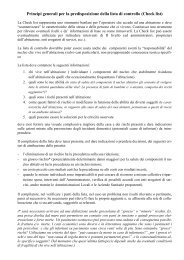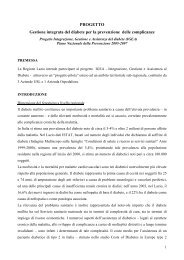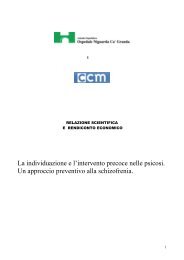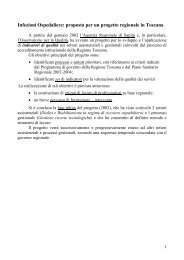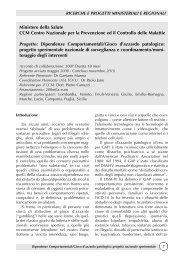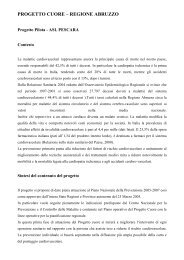Gaining health : analysis of policy development in European ...
Gaining health : analysis of policy development in European ...
Gaining health : analysis of policy development in European ...
Create successful ePaper yourself
Turn your PDF publications into a flip-book with our unique Google optimized e-Paper software.
2.1.7. Monitor<strong>in</strong>g and evaluation<br />
F<strong>in</strong>land has had regular surveillance systems <strong>in</strong> place for<br />
many years, provid<strong>in</strong>g an excellent database for the monitor<strong>in</strong>g<br />
and evaluation <strong>of</strong> <strong>health</strong> <strong>policy</strong>. Considerable effort<br />
is made to provide data on the local level and give local<br />
authorities support <strong>in</strong> the use and process<strong>in</strong>g <strong>of</strong> such data.<br />
The quality has been enhanced through pilot projects to<br />
improve the standardization <strong>of</strong> data and test hypotheses.<br />
Evaluation takes place on various levels from that <strong>of</strong> general<br />
<strong>policy</strong> to evaluat<strong>in</strong>g the effectiveness <strong>of</strong> specific methods <strong>of</strong><br />
treatment.<br />
F<strong>in</strong>land reports regularly to <strong>in</strong>ternational organizations<br />
such as WHO and the EU, participates actively <strong>in</strong> Nordic<br />
monitor<strong>in</strong>g exercises, and collaborates closely with the<br />
Baltic countries. Indeed, <strong>in</strong> the 1980s and 1990s, efforts expended<br />
<strong>in</strong> <strong>in</strong>ternational monitor<strong>in</strong>g and evaluation exercises<br />
perhaps detracted to some extent from similar domestic<br />
exercises, particularly from the need to discuss broadly the<br />
<strong>policy</strong> implications <strong>of</strong> the results. Undoubtedly, however, a<br />
valuable body <strong>of</strong> <strong>in</strong>ternationally comparable <strong>in</strong>formation and<br />
exchange <strong>of</strong> experience has been created.<br />
Health 2015 goes a step further, call<strong>in</strong>g for the regular<br />
monitor<strong>in</strong>g and evaluation activities <strong>of</strong> the Government and<br />
<strong>in</strong>dividual m<strong>in</strong>istries to <strong>in</strong>clude progress <strong>in</strong> <strong>health</strong> <strong>policy</strong> implementation.<br />
In particular, the social and <strong>health</strong> report made to<br />
Parliament every four years is expected to <strong>in</strong>dicate progress<br />
across sectors and at different levels <strong>of</strong> government.<br />
Health 2015 also cont<strong>in</strong>ued the F<strong>in</strong>nish tradition <strong>of</strong> seek<strong>in</strong>g<br />
constructive criticism and provided for an external<br />
evaluation <strong>of</strong> <strong>health</strong> promotion structures, resources and<br />
activities. This took place <strong>in</strong> collaboration with WHO <strong>in</strong><br />
2001 (12). An external evaluation <strong>of</strong> national <strong>health</strong> <strong>policy</strong> is<br />
expected dur<strong>in</strong>g the present decade.<br />
S<strong>in</strong>ce this type <strong>of</strong> evaluation is not widespread across<br />
Europe, it is worth highlight<strong>in</strong>g the F<strong>in</strong>nish attitude towards<br />
critical evaluation. For example, when <strong>in</strong> 1989 the terms <strong>of</strong><br />
reference for the first WHO review <strong>of</strong> the F<strong>in</strong>nish Health<br />
for All <strong>policy</strong> were be<strong>in</strong>g agreed, the then M<strong>in</strong>ister was<br />
asked what the position would be if the external review<br />
group expressed views unattractive for F<strong>in</strong>land and with<br />
which domestic experts did not agree. Her reply was, “You<br />
publish whatever you f<strong>in</strong>d”.<br />
2.2. Health promotion strategy<br />
Health 2015 was considered to deal largely with <strong>health</strong><br />
promotion and disease prevention issues and there was<br />
therefore no separately labelled “<strong>health</strong> promotion strategy”.<br />
However, the new government action plan calls for<br />
a strategic plan for <strong>health</strong> promotion. An ad hoc work<strong>in</strong>g<br />
group set up <strong>in</strong> MSAH has almost completed its work.<br />
2.3. Health services policies<br />
Even though the municipalities were owners <strong>of</strong> PHC centres<br />
and hospitals, MSAH closely controlled <strong>health</strong> care <strong>development</strong><br />
until the early 1990s by earmark<strong>in</strong>g fund<strong>in</strong>g for<br />
<strong>in</strong>vestment and staff<strong>in</strong>g. In 1993, the M<strong>in</strong>istry <strong>of</strong> the Interior<br />
brought <strong>in</strong> far-reach<strong>in</strong>g reforms, giv<strong>in</strong>g greater autonomy<br />
to the municipalities by replac<strong>in</strong>g earmarked subsidies with<br />
block grants. Similar changes were tak<strong>in</strong>g place <strong>in</strong> other<br />
Scand<strong>in</strong>avian countries such as Denmark, and with similar<br />
results. In return for greater autonomy at the local level,<br />
the central level had to compromise on the achievement<br />
<strong>of</strong> centrally def<strong>in</strong>ed targets. In recognition <strong>of</strong> the problem<br />
<strong>of</strong> balanc<strong>in</strong>g local autonomy with considerations <strong>of</strong> equality,<br />
Norway and Sweden have apparently preferred to compromise<br />
local autonomy to some extent <strong>in</strong> the <strong>in</strong>terest <strong>of</strong><br />
greater equality <strong>in</strong> relation to child care, for example (22).<br />
S<strong>in</strong>ce 1993, state support for statutory services <strong>in</strong> F<strong>in</strong>land<br />
has been based on a needs-criteria formula (population, age<br />
structure, morbidity, etc.). This has led to certa<strong>in</strong> disparities<br />
among municipalities. Furthermore, the total cost <strong>of</strong> <strong>health</strong><br />
care met by households has been ris<strong>in</strong>g steeply, reach<strong>in</strong>g<br />
19% <strong>in</strong> 2003 (23), which may act as an obstacle, particularly<br />
to preventive care.<br />
Chapter 4<br />
47<br />
Case studies: <strong>policy</strong> <strong>development</strong> <strong>in</strong> countries for tackl<strong>in</strong>g noncommunicable diseases



